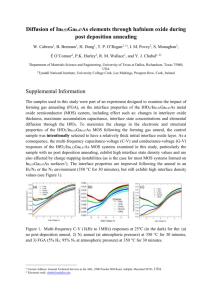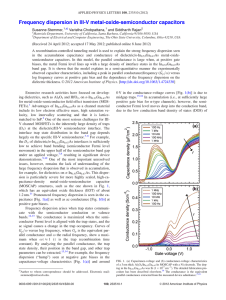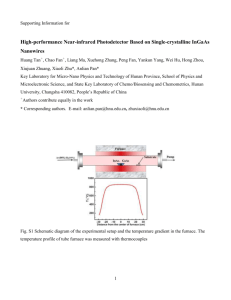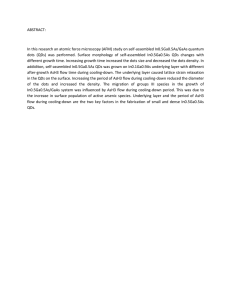High-performance self-aligned inversion-channel In0
advertisement
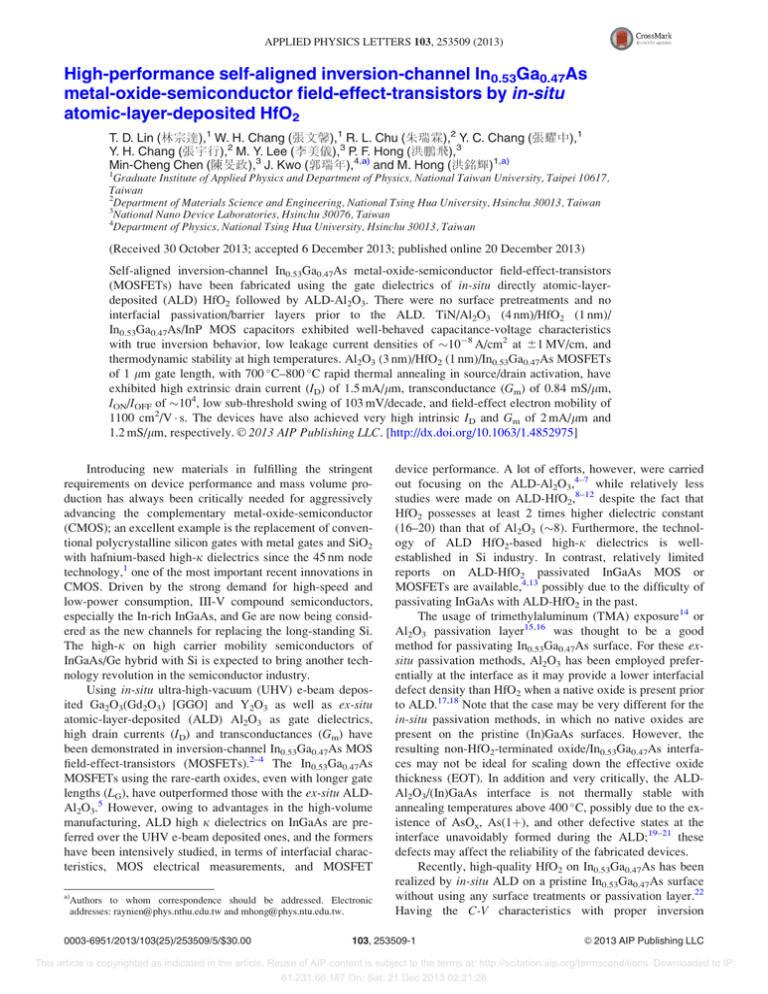
APPLIED PHYSICS LETTERS 103, 253509 (2013) High-performance self-aligned inversion-channel In0.53Ga0.47As metal-oxide-semiconductor field-effect-transistors by in-situ atomic-layer-deposited HfO2 T. D. Lin (林宗達),1 W. H. Chang (張文馨),1 R. L. Chu (朱瑞霖),2 Y. C. Chang (張耀中),1 Y. H. Chang (張宇行),2 M. Y. Lee (李美儀),3 P. F. Hong (洪鵬飛),3 Min-Cheng Chen (陳旻政),3 J. Kwo (郭瑞年),4,a) and M. Hong (洪銘輝)1,a) 1 Graduate Institute of Applied Physics and Department of Physics, National Taiwan University, Taipei 10617, Taiwan 2 Department of Materials Science and Engineering, National Tsing Hua University, Hsinchu 30013, Taiwan 3 National Nano Device Laboratories, Hsinchu 30076, Taiwan 4 Department of Physics, National Tsing Hua University, Hsinchu 30013, Taiwan (Received 30 October 2013; accepted 6 December 2013; published online 20 December 2013) Self-aligned inversion-channel In0.53Ga0.47As metal-oxide-semiconductor field-effect-transistors (MOSFETs) have been fabricated using the gate dielectrics of in-situ directly atomic-layerdeposited (ALD) HfO2 followed by ALD-Al2O3. There were no surface pretreatments and no interfacial passivation/barrier layers prior to the ALD. TiN/Al2O3 (4 nm)/HfO2 (1 nm)/ In0.53Ga0.47As/InP MOS capacitors exhibited well-behaved capacitance-voltage characteristics with true inversion behavior, low leakage current densities of 108 A/cm2 at 61 MV/cm, and thermodynamic stability at high temperatures. Al2O3 (3 nm)/HfO2 (1 nm)/In0.53Ga0.47As MOSFETs of 1 lm gate length, with 700 C–800 C rapid thermal annealing in source/drain activation, have exhibited high extrinsic drain current (ID) of 1.5 mA/lm, transconductance (Gm) of 0.84 mS/lm, ION/IOFF of 104, low sub-threshold swing of 103 mV/decade, and field-effect electron mobility of 1100 cm2/V s. The devices have also achieved very high intrinsic ID and Gm of 2 mA/lm and C 2013 AIP Publishing LLC. [http://dx.doi.org/10.1063/1.4852975] 1.2 mS/lm, respectively. V Introducing new materials in fulfilling the stringent requirements on device performance and mass volume production has always been critically needed for aggressively advancing the complementary metal-oxide-semiconductor (CMOS); an excellent example is the replacement of conventional polycrystalline silicon gates with metal gates and SiO2 with hafnium-based high-j dielectrics since the 45 nm node technology,1 one of the most important recent innovations in CMOS. Driven by the strong demand for high-speed and low-power consumption, III-V compound semiconductors, especially the In-rich InGaAs, and Ge are now being considered as the new channels for replacing the long-standing Si. The high-j on high carrier mobility semiconductors of InGaAs/Ge hybrid with Si is expected to bring another technology revolution in the semiconductor industry. Using in-situ ultra-high-vacuum (UHV) e-beam deposited Ga2O3(Gd2O3) [GGO] and Y2O3 as well as ex-situ atomic-layer-deposited (ALD) Al2O3 as gate dielectrics, high drain currents (ID) and transconductances (Gm) have been demonstrated in inversion-channel In0.53Ga0.47As MOS field-effect-transistors (MOSFETs).2–4 The In0.53Ga0.47As MOSFETs using the rare-earth oxides, even with longer gate lengths (LG), have outperformed those with the ex-situ ALDAl2O3.5 However, owing to advantages in the high-volume manufacturing, ALD high j dielectrics on InGaAs are preferred over the UHV e-beam deposited ones, and the formers have been intensively studied, in terms of interfacial characteristics, MOS electrical measurements, and MOSFET a) Authors to whom correspondence should be addressed. Electronic addresses: raynien@phys.nthu.edu.tw and mhong@phys.ntu.edu.tw. 0003-6951/2013/103(25)/253509/5/$30.00 device performance. A lot of efforts, however, were carried out focusing on the ALD-Al2O3,4–7 while relatively less studies were made on ALD-HfO2,8–12 despite the fact that HfO2 possesses at least 2 times higher dielectric constant (16–20) than that of Al2O3 (8). Furthermore, the technology of ALD HfO2-based high-j dielectrics is wellestablished in Si industry. In contrast, relatively limited reports on ALD-HfO2 passivated InGaAs MOS or MOSFETs are available,4,13 possibly due to the difficulty of passivating InGaAs with ALD-HfO2 in the past. The usage of trimethylaluminum (TMA) exposure14 or Al2O3 passivation layer15,16 was thought to be a good method for passivating In0.53Ga0.47As surface. For these exsitu passivation methods, Al2O3 has been employed preferentially at the interface as it may provide a lower interfacial defect density than HfO2 when a native oxide is present prior to ALD.17,18 Note that the case may be very different for the in-situ passivation methods, in which no native oxides are present on the pristine (In)GaAs surfaces. However, the resulting non-HfO2-terminated oxide/In0.53Ga0.47As interfaces may not be ideal for scaling down the effective oxide thickness (EOT). In addition and very critically, the ALDAl2O3/(In)GaAs interface is not thermally stable with annealing temperatures above 400 C, possibly due to the existence of AsOx, As(1þ), and other defective states at the interface unavoidably formed during the ALD;19–21 these defects may affect the reliability of the fabricated devices. Recently, high-quality HfO2 on In0.53Ga0.47As has been realized by in-situ ALD on a pristine In0.53Ga0.47As surface without using any surface treatments or passivation layer.22 Having the C-V characteristics with proper inversion 103, 253509-1 C 2013 AIP Publishing LLC V This article is copyrighted as indicated in the article. Reuse of AIP content is subject to the terms at: http://scitation.aip.org/termsconditions. Downloaded to IP: 61.231.66.187 On: Sat, 21 Dec 2013 02:21:28 253509-2 Lin et al. behaviors and low leakage current densities, the ALDHfAlO/HfO2/In0.53Ga0.47As MOS capacitors (MOSCAPs) have demonstrated low and nearly flat spectrum of interfacial trap densities (Dit’s) in the bandgap of In0.53Ga0.47As, in absence of any mid-gap peak feature. Moreover, the HfAlO/ HfO2/In0.53Ga0.47As oxide/semiconductor stack also exhibited thermodynamic stability with rapid thermal annealing (RTA) to 800 C, approaching what has been achieved in GGO/(In)GaAs, which remains intact with RTA to 900 C.23,24 In this work, the inversion-channel In0.53Ga0.47As MOSFETs passivated by in-situ ALD-HfO2 have been demonstrated using a self-aligned gate-first process. The capability of conducting in-situ ALD growth of high j dielectrics in conjunction with molecular beam epitaxy (MBE) growth of the III-V semiconductor pristine surface provides a clean HfO2/In0.53Ga0.47As interface free of As-related defective bonding,22,25 vital for achieving excellent device performance. The outstanding thermodynamic stability of the MOS heterostructure, rarely reported for ALD-high j dielectrics on InGaAs, is the key for a successful implementation of self-aligned gate-first process. The ALD-Al2O3/HfO2/ In0.53Ga0.47As MOSFETs exhibit excellent device characteristics including very high ID and Gm, good ION/IOFF ratio, and low sub-threshold swing (SS). The epi-layer structures and device configurations of the inversion-channel In0.53Ga0.47As MOSFETs are similar to those reported in our previous work.2,3 P-type In0.53Ga0.47As buffer layers and channel layers with Be doping concentrations of 5 1017 cm3 and 1 1017 cm3, respectively, were grown on Pþ epi-ready InP(001) substrates using MBE. The In0.53Ga0.47As/ InP wafers with pristine (4 2)-reconstructed In/Ga stabilized In0.53Ga0.47As(001) surfaces were transR ALD reactor for ferred to a customized Picosun SUNALEV in-situ deposition of ALD-HfO2 and Al2O3.19 All the transfers of samples between the UHV chambers and the ALD reactor were carried out in UHV transfer modules with a background pressure of 1010 Torr. 10-cycle (1 nm) ALDHfO2 was first deposited on the In0.53Ga0.47As surface, followed by the deposition of ALD-Al2O3. The ALD used Tetrakis[EthylMethylAmino]Hafnium (TEMAHf), TMA and de-ionized water as precursors, and high purity (99.9999%) nitrogen as carrier gas. The deposition temperatures for both HfO2 and Al2O3 were kept at about 320 C. ALD-Al2O3 was employed as the top oxide layer for simplifying device fabrication process, which can be replaced with any other high j dielectrics to increase the oxide capacitance in the future.22 After post-deposition-annealing at 500 C for 30 min in a N2 ambience, the samples were sequentially covered by ALD-TiN 20 nm and sputtered-TiN 160 nm thick, as the gate metal. MOSCAPs were made by patterning and dry etching top TiN electrodes using inductively coupled plasma reactive ion etching (ICP-RIE), wet-etching oxides at back-side of substrates, and depositing AuBe/Ni as the back electrodes. The MOSCAPs have subsequently been postmetallization annealed (PMA) at 700 C for 10 s in N2 ambience. The inversion-channel MOSFETs were fabricated with a previously published self-aligned gate-first process,2,3 using Pd/ Ge/Ti/Pt metal stacks as n-type source/drain (S/D) contacts, Appl. Phys. Lett. 103, 253509 (2013) AuBe/Ni as p-type body contacts, and Ti/Pt/Au as the metal pads. Note that the oxide etching at n- and p-contact regions of the MOSFETs was also carried out using ICP-RIE, a dry process, unlike the wet etching process used in our previous work. The activation and ohmic alloying temperatures are 700 C–800 C and 400 C, respectively. Electrical characteristics were measured using Agilent 4284A Precision LCR Meter and Agilent 4156 C Precision Semiconductor Parameter Analyzer. Room-temperature capacitance-voltage (C-V) and leakage current density-electric field (J-E) characteristics of TiN/ Al2O3 (4 nm)/HfO2 (1 nm)/In0.53Ga0.47As/InP MOSCAPs, which experienced 700 C PMA, were shown in Fig. 1. At the strong inversion region, the C-V traces exhibit bias independent capacitances at specific frequencies, indicating a true inversion behavior.16,26 Noticeable frequency dispersion in accumulation regions was observed, as reported in our earlier work.22 The origin of the dispersion is under investigation, which may be resulted from interfacial traps near the valance band side in the band gap of In0.53Ga0.47As, border traps located near the oxide/In0.53Ga0.47As interface,27 or other defects,28 and requires further discussion. The J-E curves of the MOSCAPs shown in the inset exhibit low leakage current densities of 108 A/cm2 at 61MV/cm. The well-behaved C-V and J-E characteristics prove that the MOS stack, including the ALD-HfO2/In0.53Ga0.47As, remains intact with RTA to 700 C; the outstanding thermodynamic stability, which ensures sufficient dopant activation, and the preserved high-quality interfaces are imperative for realizing high-performance self-aligned inversion channel In0.53Ga0.47As MOSFETs. Figure 2(a) shows the DC output characteristics, ID-VD curves, of a self-aligned inversion-channel Al2O3 (3 nm)/ HfO2 (1 nm)/In0.53Ga0.47As MOSFET with LG of 1 lm, measured with gate bias (VG) varying from 0 to þ2.5 V in steps of þ0.5 V and drain bias (VD) sweeping from 0 to þ2 V. The MOSFET exhibited a maximum drain current (ID) of 1.5 mA/lm at VG ¼ 2.5 V and VD ¼ 2 V. The high inversion drain current confirmed the true inversion behavior observed in the aforementioned C-V characteristics of the MOSCAPs from the same wafer. The Gm curve of the same device is shown in Fig. 2(b), exhibiting a peak value of FIG. 1. C-V characteristics of a TiN/Al2O3 (4 nm)/HfO2 (1 nm)/ In0.53Ga0.47As/InP MOSCAP subjected to 700 C PMA. The inset shows J-E curves of the MOSCAP. This article is copyrighted as indicated in the article. Reuse of AIP content is subject to the terms at: http://scitation.aip.org/termsconditions. Downloaded to IP: 61.231.66.187 On: Sat, 21 Dec 2013 02:21:28 253509-3 Lin et al. Appl. Phys. Lett. 103, 253509 (2013) FIG. 3. ID vs. VG of a 1lm-gate-length inversion-channel ALD-Al2O3 (3 nm)/HfO2 (1 nm)/In0.53Ga0.47As MOSFET measured at VD ¼ 50 mV and 1 V, showing a DIBL of 47 mV/V, a SS of 103 mV/decade, and an ION/IOFF of 104. FIG. 2. (a) Output characteristics ID vs. VD of a 1 lm-gate-length inversionchannel ALD-Al2O3 (3 nm)/HfO2 (1 nm)/In0.53Ga0.47As MOSFET, demonstrating a maximum ID of 1.5 mA/lm at VG ¼ 2.5 V and VD ¼ 2 V. (b) Transfer characteristics and Gm curve of the same device, exhibiting a peak Gm of 0.84 mS/lm at VD ¼ 2 V. Intrinsic ID and Gm are also shown in this figure. 0.84 mS/lm at VD ¼ 2 V. The threshold voltage (VT) of this inversion channel device extracted by linear extrapolation is 0.24 V; in other words, the device was operated in an enhancement mode, which is extremely important for CMOS application. High values of ID and Gm29,30 were relatively easily attained in depletion-mode31 In0.53Ga0.47As MOSFETs, as the oxide/In0.53Ga0.47As interfacial quality plays a less critical role in device performances. However, the depletion-mode MOSFETs are not applicable to CMOS. From the data measured at VD ¼ 50 mV, a peak fieldeffect electron mobility of 1100 cm2/Vs was estimated via transconductance analysis.2,3 Using the transmission line method (TLM), specific contact resistivity of the metal/ semiconductor junction and sheet resistance were calculated to be 4 106 X cm2 and 29 X/sq., respectively. Intrinsic Gm was further extracted by eliminating the effects of parasitic series resistance at S/D regions,32 and intrinsic ID was subsequently derived. The MOSFETs have achieved very high intrinsic ID and Gm of 2 mA/lm and 1.2 mS/lm, respectively, as shown in Fig. 2(b). Nevertheless, the ohmic contact needs to be further improved to at least 1 108 X cm2 for achieving better extrinsic device performance. ID-VG characteristics of an Al2O3 (3 nm)/HfO2 (1 nm)/ In0.53Ga0.47As MOSFET measured under VD of 50 mV and 1 V are shown in Fig. 3. This device exhibits good ION/IOFF of 104. The extracted drain-induced-barrier-lowering (DIBL) and SS is 47 mV/V and 103 mV/decade, respectively. The SS of this in-situ HfO2-passivated planar MOSFET is comparable to those of the in-situ GGO- and Y2O3-passivated MOSFETs and smaller than those of ex-situ Al2O3-passivated MOSFETs using the same In0.53Ga0.47As channels.4,33 The high quality HfO2/In0.53Ga0.47As with low Dit, which was discussed in the previous work,22 has been attributed to the low SS. Moreover, the low SS attained in the MOSFETs with the 700 C–800 C source-drain activation indicates the robustness of the HfO2/In0.53Ga0.47As interface, again proving effective passivation of In0.53Ga0.47As using in-situ ALD-HfO2. Note that SS’s of 150 to 200 mV/decade, or even higher, have commonly been observed for self-aligned planar In0.53Ga0.47As MOSFETs subjected to activation temperature higher than 650 C, even with the application of special passivation techniques.34,35 Maximum ID and peak Gm of the recently reported stateof-the-art In0.53Ga0.47As MOSFETs are summarized in Fig. 4. The MOSFETs are passivated by in-situ ALD-Al2O3/ HfO2 (this work) as well as ex-situ ALD-HfO2 or Al2O3 with NH4OH and/or (NH4)2S pretreatments,4,6 metal-organic chemical-vapor-deposited (MOCVD)-HfAlO with (NH4)2S pretreatments plus PH3-passivation34 or silane plus ammonia (SiH4 þ NH3) passivation,35 ALD-Al2O3 with InP barrier and (NH4)2S pretreatment,7 and unspecified high j dielectrics.36 It is worth noting that some of the devices have negative VT,6,34 which is not adequate for n-MOSFETs in the CMOS applications. The MOSFET reported in this work is the only device using directly deposited ALD high j dielectrics without any surface pretreatments or passivation/barrier layers and is also the only device exhibiting comparable maximum ID and peak Gm to our previously demonstrated high-performance In0.53Ga0.47As MOSFETs using UHVdeposited GGO and Y2O3 at similar gate length. Maximum ID/peak Gm of the GGO- and Y2O3-In0.53Ga0.47As MOSFETs are 1.05 mA/lm/0.71 mS/lm and 1.5 mA/lm/ 0.77 mS/lm, respectively. The extrinsic ID of 1.5 mA/lm and Gm of 0.84 mS/lm achieved by the in-situ ALD-HfO2 passivated In0.53Ga0.47As MOSFET outperform those of all the other planar devices using HfO2-based high j dielectrics, and they are comparable to those exhibited by threedimensional (3D) tri-gates or gate-all-around devices using ALD-Al2O3. ALD-HfO2 with 1 nm thickness was used in this work, as thicker amorphous HfO2 films with 500 C annealing tend to recrystallize to form epitaxial films consisting of four domains which rotate 90 with respect to each other.37,38 This article is copyrighted as indicated in the article. Reuse of AIP content is subject to the terms at: http://scitation.aip.org/termsconditions. Downloaded to IP: 61.231.66.187 On: Sat, 21 Dec 2013 02:21:28 253509-4 Lin et al. Appl. Phys. Lett. 103, 253509 (2013) evidence of successful passivation of In0.53Ga0.47As MOFETs using in-situ ALD-HfO2, and opens up the possibility of fulfilling the stringent demand of InGaAs MOSFETs for high performance/low power CMOS using Si-compatible HfO2-based high j dielectrics. This work was supported by National Nano Projects Nos. 101-2120-M-002-016 and 102-2112-M-002-022-MY3, and NSC 102-2622-E-002-014 of the National Science Council of Taiwan, and the Asian Office of Aerospace Research and Development of the US Air Force. 1 FIG. 4. Summary of (a) maximum drain currents and (b) peak transconductances of state-of-the-art In0.53Ga0.47As MOSFETs reported recently. Most depletion mode devices are excluded except for the two asterisked devices; one is among the very few reported high performance In0.53Ga0.47As MOSFETs using HfO2-based dielectrics and the other is the first gate-allaround In0.53Ga0.47As MOSFETs. The label near each data point indicates the dielectrics used in corresponding device. The data of devices using HfO2-based dielectrics are denoted with solid circular, square, and triangular symbols, and the data of devices using ALD-Al2O3 are denoted with hollow diamond and square symbols; the cross symbol represents the data of device using unspecified high j dielectrics. The top ALD-Al2O3 can be replaced with doped HfO2 having high recrystallization temperatures and higher j values than Al2O3. In conclusion, self-aligned inversion channel In0.53Ga0.47As MOSFETs have been demonstrated using insitu ALD high j dielectrics. The approach of in-situ ALD and bilayer interface engineering provides high quality Al2O3/HfO2/In0.53Ga0.47As with high quality HfO2/ In0.53Ga0.47As interface, outstanding thermodynamic stability, and low leakage currents. The thermodynamic stability at 700 C–800 C, rarely reported for ALD- or MOCVDhigh j dielectrics, ensures sufficient thermal budget for the self-aligned gate-first process. The ALD-Al2O3/HfO2/ In0.53Ga0.47As MOSFETs of 1 lm gate length achieved very high drain current and transconductances, outperforming other planar In0.53Ga0.47As MOSFETs using HfO2-based high j dielectrics, of similar gate lengths, and comparable to other state-of-the-art 3D tri-gates or gate-all-around In0.53Ga0.47As MOSFETs using ALD-Al2O3, of much shorter gate lengths. This work has provided striking K. Mistry, C. Allen, C. Auth, B. Beattie, D. Bergstrom, M. Bost, M. Brazier, M. Buehler, A. Cappellani, R. Chau, C. H. Choi, G. Ding, K. Fischer, T. Ghani, R. Grover, W. Han, D. Hanken, M. Hatttendorf, J. He, J. Hicks, R. Huessner, D. Ingerly, P. Jain, R. James, L. Jong, S. Joshi, C. Kenyon, K. Kuhn, K. Lee, H. Liu, J. Maiz, B. McIntyre, P. Moon, J. Neirynck, S. Pei, C. Parker, D. Parsons, C. Prasad, L. Pipes, M. Prince, P. Ranade, T. Reynolds, J. Sandford, L. Schifren, J. Sebastian, J. Seiple, D. Simon, S. Sivakumar, P. Smith, C. Thomas, T. Troeger, P. Vandervoorn, S. Williams, and K. Zawadzki, IEEE Int. Electron Dev. Meet. 2007, 247. 2 T. D. Lin, H. C. Chiu, P. Chang, L. T. Tung, C. P. Chen, M. Hong, J. Kwo, W. Tsai, and Y. C. Wang, Appl. Phys. Lett. 93, 033516 (2008). 3 P. Chang, H.-C. Chiu, T.-D. Lin, M.-L. Huang, W.-H. Chang, S.-Y. Wu, K.-H. Wu, M. Hong, and J. Kwo, Appl. Phys. Express 4, 114202 (2011). 4 Y. Xuan, Y. Q. Wu, T. Shen, T. Yang, and P. D. Ye, IEEE Int. Electron Dev. Meet. 2007, 637. 5 T. D. Lin, H. C. Chiu, P. Chang, Y. H. Chang, Y. D. Wu, M. Hong, and J. Kwo, Solid-State Electron. 54, 919 (2010). 6 J. J. Gu, Y. Q. Liu, Y. Q. Wu, R. Colby, R. G. Gordon, and P. D. Ye, IEEE Int. Electron Dev. Meet. 2011, 33.2.1. 7 X. Fei, J. Aiting, C. Yen-Ting, W. Yanzhen, Z. Fei, C. Yao-Feng, and J. Lee, IEEE Int. Electron Dev. Meet. 2012, 27.5.1. 8 N. Goel, P. Majhi, C. O. Chui, W. Tsai, D. Choi, and J. S. Harris, Appl. Phys. Lett. 89, 163517 (2006). 9 T. Yang, Y. Xuan, D. Zemlyanov, T. Shen, Y. Q. Wu, J. M. Woodall, P. D. Ye, F. S. Aguirre-Tostado, M. Milojevic, S. McDonnell, and R. M. Wallace, Appl. Phys. Lett. 91, 142122 (2007). 10 C. L. Hinkle, A. M. Sonnet, E. M. Vogel, S. McDonnell, G. J. Hughes, M. Milojevic, B. Lee, F. S. Aguirre-Tostado, K. J. Choi, H. C. Kim, J. Kim, and R. M. Wallace, Appl. Phys. Lett. 92, 071901 (2008). 11 R. D. Long, É. O’Connor, S. B. Newcomb, S. Monaghan, K. Cherkaoui, P. Casey, G. Hughes, K. K. Thomas, F. Chalvet, I. M. Povey, M. E. Pemble, and P. K. Hurley, J. Appl. Phys. 106, 084508 (2009). 12 E. A. Chagarov and A. C. Kummel, J. Chem. Phys. 135, 244705 (2011). 13 K. Y. Lee, Y. J. Lee, P. Chang, M. L. Huang, Y. C. Chang, M. Hong, and J. Kwo, Appl. Phys. Lett. 92, 252908 (2008). 14 Y. Hwang, R. Engel-Herbert, and S. Stemmer, Appl. Phys. Lett. 98, 052911 (2011). 15 A. O’Mahony, S. Monaghan, G. Provenzano, I. M. Povey, M. G. Nolan, E. O’Connor, K. Cherkaoui, S. B. Newcomb, F. Crupi, P. K. Hurley, and M. E. Pemble, Appl. Phys. Lett. 97, 052904 (2010). 16 L. K. Chu, C. Merckling, A. Alian, J. Dekoster, J. Kwo, M. Hong, M. Caymax, and M. Heyns, Appl. Phys. Lett. 99, 042908 (2011). 17 R. Suzuki, N. Taoka, M. Yokoyama, S. Lee, S. H. Kim, T. Hoshii, T. Yasuda, W. Jevasuwan, T. Maeda, O. Ichikawa, N. Fukuhara, M. Hata, M. Takenaka, and S. Takagi, Appl. Phys. Lett. 100, 132906 (2012). 18 V. Chobpattana, J. Son, J. J. M. Law, R. Engel-Herbert, C.-Y. Huang, and S. Stemmer, Appl. Phys. Lett. 102, 022907 (2013). 19 Y. H. Chang, M. L. Huang, P. Chang, J. Y. Shen, B. R. Chen, C. L. Hsu, T. W. Pi, M. Hong, and J. Kwo, Microelectron. Eng. 88, 1101 (2011). 20 M. L. Huang, Y. H. Chang, T. D. Lin, H. Y. Lin, Y. T. Liu, T. W. Pi, M. Hong, and J. Kwo, Appl. Phys. Lett. 101, 212101 (2012). 21 W. Wang, C. L. Hinkle, E. M. Vogel, K. Cho, and R. M. Wallace, Microelectron. Eng. 88, 1061 (2011). 22 T. D. Lin, Y. H. Chang, C. A. Lin, M. L. Huang, W. C. Lee, J. Kwo, and M. Hong, Appl. Phys. Lett. 100, 172110 (2012). 23 Y. L. Huang, P. Chang, Z. K. Yang, Y. J. Lee, H. Y. Lee, H. J. Liu, J. Kwo, J. P. Mannaerts, and M. Hong, Appl. Phys. Lett. 86, 191905 (2005). 24 K. H. Shiu, T. H. Chiang, P. Chang, L. T. Tung, M. Hong, J. Kwo, and W. Tsai, Appl. Phys. Lett. 92, 172904 (2008). This article is copyrighted as indicated in the article. Reuse of AIP content is subject to the terms at: http://scitation.aip.org/termsconditions. Downloaded to IP: 61.231.66.187 On: Sat, 21 Dec 2013 02:21:28 253509-5 25 Lin et al. T. W. Pi, H. Y. Lin, T. H. Chiang, Y. T. Liu, G. K. Wertheim, J. Kwo, and M. Hong, J. Appl. Phys. 113, 203703 (2013). 26 E. O’Connor, S. Monaghan, K. Cherkaoui, I. M. Povey, and P. K. Hurley, Appl. Phys. Lett. 99, 212901 (2011). 27 D. H. C. Lin, G. Brammertz, S. Sioncke, L. Nyns, A. Alian, W.-E. Wang, M. Heyns, M. Caymax, and T. Hoffmann, ECS Trans. 34, 1065 (2011). 28 C. L. Hinkle, E. M. Vogel, P. D. Ye, and R. M. Wallace, Curr. Opin. Solid State Mater. Sci. 15, 188 (2011). 29 M. Egard, L. Ohlsson, B. M. Borg, F. Lenrick, R. Wallenberg, L. E. Wernersson, and E. Lind, IEEE Int. Electron Dev. Meet. 2011, 13.2.1. 30 Y. Yonai, T. Kanazawa, S. Ikeda, and Y. Miyamoto, IEEE Int. Electron Dev. Meet. 2011, 13.3.1. 31 Y. C. Wang, M. Hong, J. M. Kuo, J. P. Mannaerts, J. Kwo, H. S. Tsai, J. J. Krajewski, Y. K. Chen, and A. Y. Cho, IEEE Electron Device Lett. 20, 457 (1999). Appl. Phys. Lett. 103, 253509 (2013) S. Y. Chou and D. A. Antoniadis, IEEE Trans. Electron Device 34, 448 (1987). H. C. Lin, W. E. Wang, G. Brammertz, M. Meuris, and M. Heyns, Microelectron. Eng. 86, 1554 (2009). 34 H. J. Oh, J. Q. Lin, S. A. B. Suleiman, G. Q. Lo, D. L. Kwong, D. Z. Chi, and S. J. Lee, IEEE Int. Electron Dev. Meet. 2009, 1. 35 H. C. Chin, X. K. Liu, X. Gong, and Y. C. Yeo, IEEE Trans. Electron Devices 57, 973 (2010). 36 M. Radosavljevic, G. Dewey, D. Basu, J. Boardman, B. Chu-Kung, J. M. Fastenau, S. Kabehie, J. Kavalieros, V. Le, W. K. Liu, D. Lubyshev, M. Metz, K. Millard, N. Mukherjee, L. Pan, R. Pillarisetty, W. Rachmady, U. Shah, H. W. Then, and R. Chau, IEEE Int. Electron Dev. Meet. 2011, 33.1.1. 37 C. H. Hsu, P. Chang, W. C. Lee, Z. K. Yang, Y. J. Lee, M. Hong, J. Kwo, C. M. Huang, and H. Y. Lee, Appl. Phys. Lett. 89, 122907 (2006). 38 S. C. Liou, M. W. Chu, C. H. Chen, Y. J. Lee, P. Chang, W. C. Lee, M. Hong, and J. Kwo, Appl. Phys. A 91, 585 (2008). 32 33 This article is copyrighted as indicated in the article. Reuse of AIP content is subject to the terms at: http://scitation.aip.org/termsconditions. Downloaded to IP: 61.231.66.187 On: Sat, 21 Dec 2013 02:21:28
